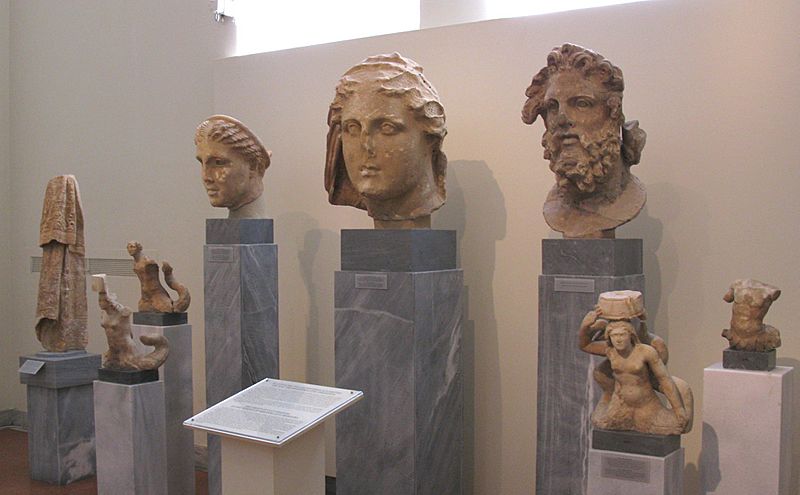Image: The Hellenistic Sculpture (3471629378)

Description: THE HELLENISTIC SCULPTURE The Hellenistic period is the interval between the rise to power of Alexander the Great in Macedonia and the whole of Greece (336 BC) and the naval Battle of Actium (31BC). As elected 'strategos autocrator' of the Greeks, he set off on campaign to the East in 334 BC. The dissolution of the Persian kingdom and the conquest of Phoenicia, Egypt and India (334-323 BC) led to the creation of a new empire, in which the Greek language and culture were disseminated and acquired an ecumenical character. The centres of development were transferred to the East, and the Greek city-states lost then* autonomy and entered upon gradual political decline. The major political and cultural centres were now located in new areas and the fame and influence of the cities of the Greek homeland was reduced. A change in art became evident from the late 4th c. BC, as the three-dimensional was conquered, with the modelling of figures, which opened up easily in space. The work of two great sculptors, Praxiteles and Lysippos, laid the foundations for later developments. The characteristic feature of the Hellenistic sculpture is its realism, expressed either in sculptures showing everyday occupations of ordinary people, or -reaching the point of excess- in representations of mythological scenes and heroes, full of passion, vigorous movement and theatricality. The clearest manifestation of realism, though, is found in the art of the portrait that began to flourish at the time of Alexander the Great and continued to do so under his successors, giving expression to their political ideology and aspirations. Portrayals of philosophers embody their teaching with admirable psychological insight, while realistic features intruded increasingly into portraits of individuals. In addition to Athens, Rhodes, Alexandria, Pergamon and other cities in Asia Minor emerged as flourishing sculpture centres in the Hellenistic period. A feature of the period was the mobility of the artists, which led to creative exchanges of repertoire and style. A large number of artists and their works are known to us: Skopas, Bryaxis, Doidalsas, Polyeuktos, Chairestratos, Damophon, Eukleides, Chares and Pasiteles are just a few of the sculptors who travelled to the courts of rulers or received commissions from wealthy private individuals and created superb pieces of sculpture. These artists laid the foundations for a variety of expressive manners that exercised a rofound influence on the sculpture of the Western World. --- Η ΓΛΥΠΤΙΚΗ ΤΗΣ ΕΛΛΗΝΙΣΤΙΚΗΣ ΕΠΟΧΗΣ Ως ελληνιστική εποχή ορίζεται το διάστημα από την ανάρρηση του Μεγάλου Αλεξάνδρου στο θρόνο του Μακεδόνικου βασιλείου (336 π.Χ.) έως τη ναυμαχία του Ακτίου (31 π.Χ.). Ως εκλεγμένος «στρατηγός αυτοκράτωρ» των Ελλήνων, ο Μέγας Αλέξανδρος εκστρατεύει το 334 π.Χ. προς Ανατολάς. Με την κατάλυση του περσικού βασιλείου και την κατάκτηση της Φοινίκης, της Αιγύπτου και της Ινδικής (334-323 π.Χ.) δημιουργείται μία νέα αυτοκρατορία, όπου μεταλαμπαδεύεται η ελληνική γλώσσα και ο πολιτισμός αποκτά οικουμενικό χαρακτήρα. Οι ελληνικές πόλεις-κράτη χάνουν την αυτονομία τους και οδηγούνται σε πολιτική παρακμή. Τα πολιτικά και πολιτιστικά κέν ρα μετατοπίζονται γεωγραφικώς και η ακτινοβολία των πόλεων της κυρίως Ελλάδας περιορίζεται. Από τα τέλη του 4ου αι. π.Χ. γίνεται αισθητή η αλλαγή στην τέχνη, καθώς κατακτάται η τρίτη διάσταση στο πλάσιμο των μορφών και αυτές ανοίγονται με άνεση στο χώρο. Το έργο δύο μεγάλων γλυπτών, του Πραξιτέλη και του Λυσίππου, θέτει τις βάσεις για τις κατοπινές εξελίξεις. Το κύριο χαρακτηριστικό της γλυπτικής των ελληνιστικών χρόνων είναι ο ρεαλισμός, είτε πρόκειται για έργα που παριστάνουν το στιγμιαίο και τις καθημερινές ασχολίες των απλών ανθρώπων είτε -στην υπερβολή του- σε απεικονίσεις μυθολογικών σκηνών και ηρώων γεμάτων πάθος, έντονη κίνηση και θεατρικότητα. Η πιο σαφής, όμως, έκφανση του ρεαλισμού βρίσκεται στην τέχνη του πορτραίτου που ξεκινά στα χρόνια του Μεγάλου Αλεξάνδρου και συνεχίζεται στην εποχή των διαδόχων του, ως έκφραση της πολιτικής ιδεολογίας και των επιδιώξεων τους. Στις απεικονίσεις των φιλοσόφων επιχειρείται να αποτυπωθούν οι αρχές της διδασκαλίας τους και επιτυγχάνεται η απόδοση θαυμαστής ψυχογραφικής εκφραστικότητας. Στα ελληνιστικά χρόνια, εκτός από την Αθήνα, αναδεικνύονται σε ακμαία κέντρα καλλιτεχνικής παραγωγής η Ρόδος, η Αλεξάνδρεια, η Πέργαμος και άλλες πόλεις της Μικρός Ασίας. Χαρακτηριστικό της εποχής είναι η κινητικότητα των καλλιτεχνών, στοιχείο που οδήγησε σε δημιουργικές ανταλλαγές τόσο στο θεματολόγιο όσο και στην τεχνοτροπία. Τα ονόματα πλήθους καλλιτεχνών, αλλά και έργα τους, είναι γνωστά: ο Σκόπας, ο Βρύαξις, ο Δοιδάλσας, ο Πολύευκτος, ο Χαιρέστρατος, ο Δαμοφών, ο Ευκλείδης, ο Χάρης και ο Πασιτέλης είναι λίγοι μόνο γλύπτες από εκείνους που, μετακινούμενοι στις αυλές των ηγεμόνων ή αναλαμβάνοντας παραγγελίες πλούσιων ιδιωτών, φιλοτέχνησαν περίφημα έργα και έθεσαν τις βάσεις ποικίλων εκφραστικών τρόπων που επηρέασαν βαθύτατα τη γλυπτική του Δυτικού κόσμου.
Title: The Hellenistic Sculpture (3471629378)
Credit: The Hellenistic Sculpture Uploaded by Marcus Cyron
Author: Tilemahos Efthimiadis from Athens, Greece
Usage Terms: Creative Commons Attribution 2.0
License: CC BY 2.0
License Link: http://creativecommons.org/licenses/by/2.0
Attribution Required?: Yes
Image usage
The following page links to this image:

